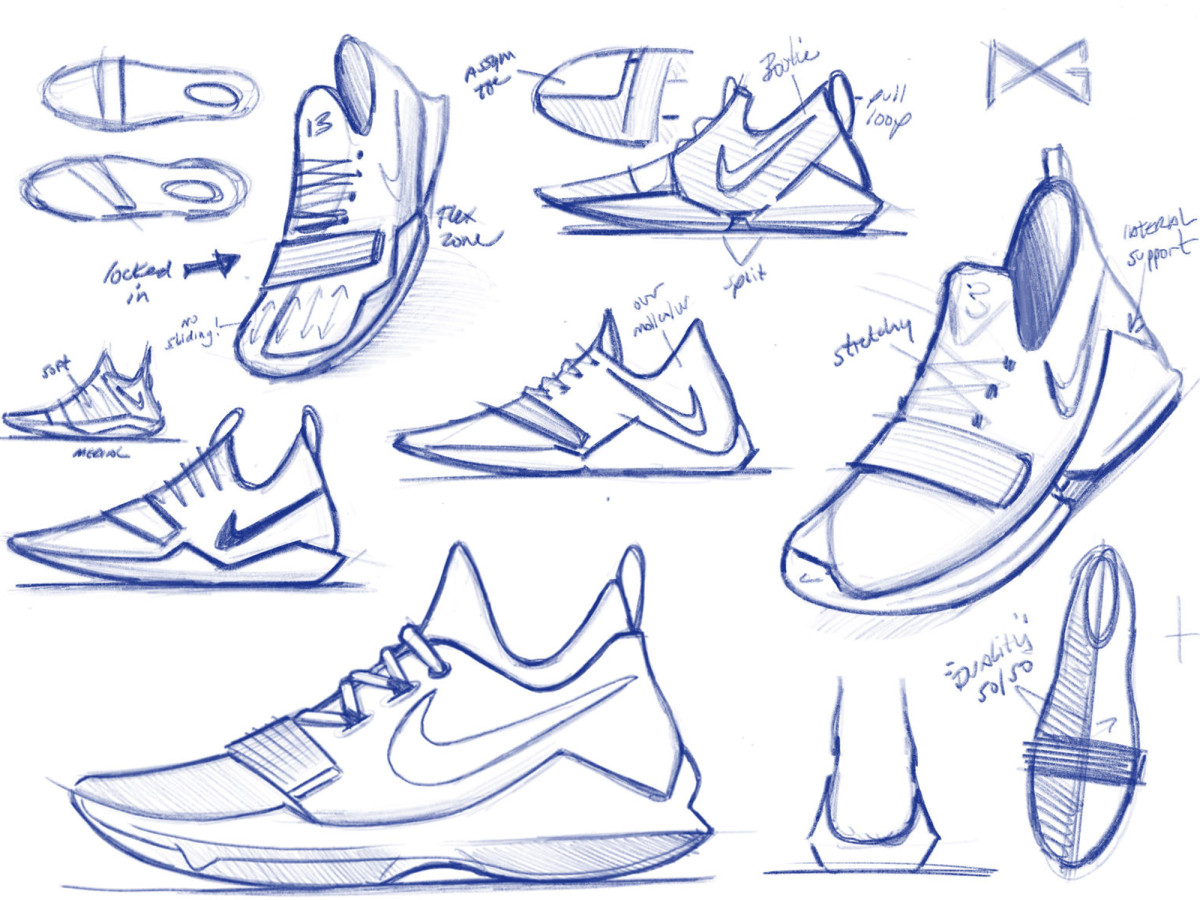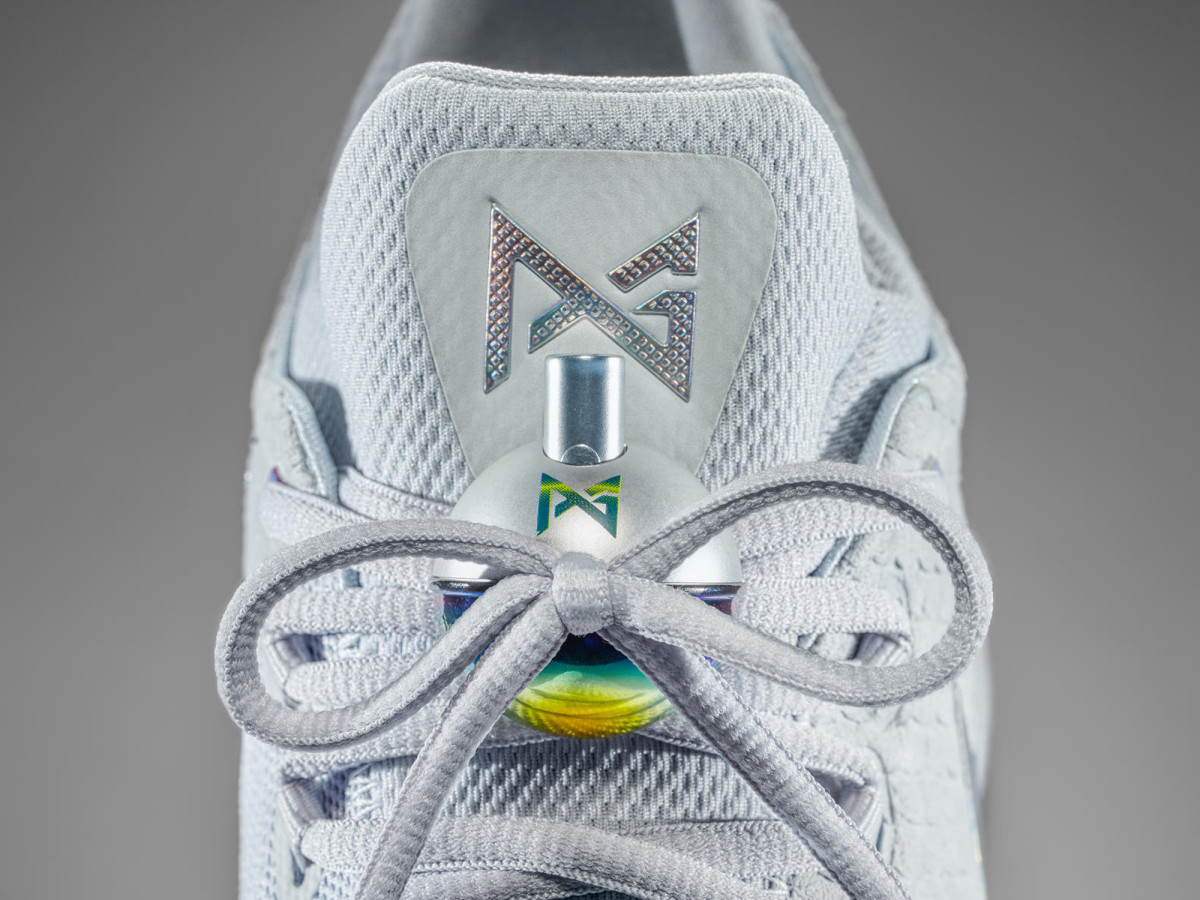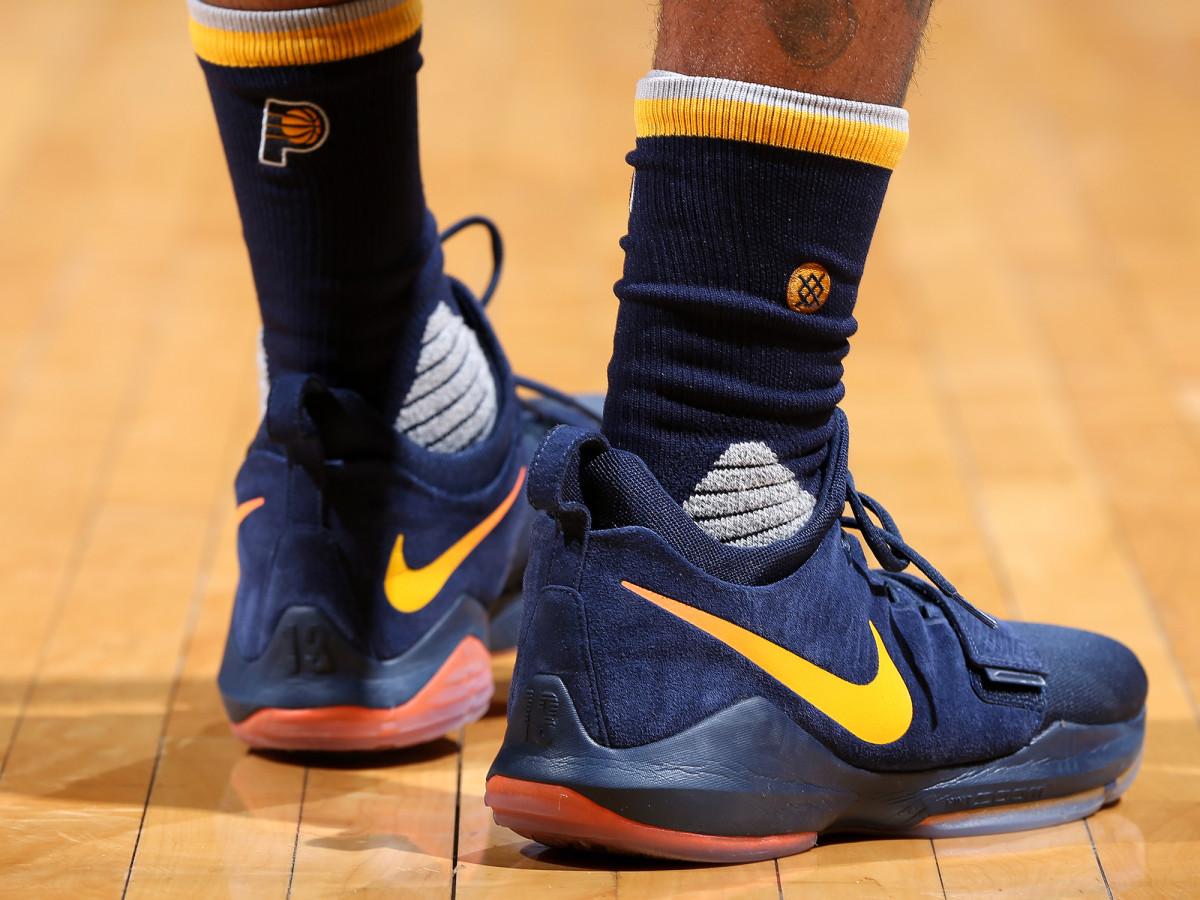Behind The Design: Inside The Making Of Paul George's Signature Shoe

Joining Nike’s signature roster is one of the most exclusive invitations in the sporting industry. Throughout the brand's 44-year history, fewer than 1% of the brands athletes have been given a signature shoe. The last time Nike granted a signature basketball sneaker, it was to Kyrie Irving at the end of 2014. When the Nike Kyrie 1 was released, past and current signature athletes all welcomed into the fraternity. It’s a club that consists of names like Michael Jordan, Penny Hardaway, LeBron James, Kobe Bryant, and Kevin Durant. LeBron has called it a “brotherhood”.
Now a little more than two years after Irving's sneaker, Nike unveiled this past month that Pacers forward Paul George will become its 21st signature basketball athlete. The Nike PG1, designed by designer Tony Hardman, pays homage to the '90s era with its materials while also following one of today's trends with a low-cut build. The sneaker features a forefoot strap with Flywire technology loop system that provides adaptive support, while the Zoom Air unit and sockliner provide responsive cushioning. Another standout in the sneaker is the personal details that could be found throughout the silhouette. You can find nods like a bobber-inspired lace lock for his favorite hobby: fishing. There is also a limited NBA 2K colorway that explores PG-13’s love for video games. The PG1 will release March 4th at a retail price of $110.
The Crossover spoke with Hardman about designing the PG1 and got the inside scoop on how Nike plans out their signature basketball calendar.
The Celtics' Balancing Act Is Getting Interesting
Jarrel Harris: Can you talk about some of the design inspirations for the PG1?
Tony Hardman: A lot of it was really driven by Paul, and I think he’s been more involved than athletes typically are. With his injury we kind of stretched the process out a little bit. We had shown him the first sketches a week before he broke his leg. The plan was for the shoe to come out a lot earlier, but we weren't sure how his comeback would look and we were able to spend a lot of time with him to understand his style, his personality and a lot of things he wanted in the shoe.
He also had his own little sketch that he did. He’s a big sneakerhead, he’s really passionate about shoes. It was cool to see that and the sketch actually had the forefoot strap on it, so it was interesting to see that from him. The other thing too was that he was wearing a shoe that was too small for him. So he was smashing his toes and was kind used to this really tight fit. But as a team it was all about getting him into his correct size, a 14 versus a 13, but we wanted to still give him that snug fit that he really likes. So that is what really drove the forefoot strap.
JH: What part of Paul's game was considered while making the shoe?
TH: As you may know, he is a really dynamic player on both ends of the floor so keeping him locked in laterally was really important as well. The other thing too that he talks about was that he wanted his shoe to be the most comfortable shoe in the line. With the Zoom Air Unit, we know he needs explosiveness on court which is important, but also putting this sneaker sockliner in so that the comfort is just amazing, and then also having this seamless bootie that just hugs your foot. We love the Crusader so of it was driven from that. From a style standpoint, one thing that was really unique that he asked for was to kind use of natural materials, like leathers, which we haven't used in years. You can start to see some of that stuff trending back in now, but at the time he was asking for it, it was unheard of. Everything was fuse or knit or mesh so we were like wow, so it was like a leap when he was asking for it. In terms of a street crossover, style-wise it ended up being really relevant.

JH: Why do you think it was the right time for a Paul George signature sneaker?
TH: At the time that we initially signed Paul, he was killing it. It was him vs. LeBron. He was just stepping into the limelight and was being heralded as one of the game’s best two-way players, and I think Nike gravitated towards that. It was really his passion. He was always this kind of underdog and not one of these guys like LeBron who was heralded all the way back in high school, he kind of had to earn everything. And he’s really just a really humble, cool guy. I think kids could relate to him due to the fact that he has to work from everything that he has gotten.
JH: What was his reaction when he finally saw the shoe?
TH: Well, it kind of came in stages. We tried some things initially that he wasn't really feeling, and it was a little push and pull so it’s not like we went to him and revealed the shoe. We were showing him some really cobbled up stuff with tape on it or just not the right materials, and 3D printed parts he wasn't really used to seeing, so it wasn't like this shock when we dropped the finish product on him, but I think when he finally came to campus and we revealed all of the colorways, the finishes and his logo and everything, he was just so humbled and honored to be a part of this process, and even now when we talk to him about the 1’s he is still on some kind of in disbelief about the whole process. He is just really humbled by it.

JH: What are some of your favorite details and features in the sneaker?
TH: For me, I really love some of the fish scale inspired details. If you look at the traction that’s really like a multi-directional functionality about it in terms of what he needs but then it has this nod to fishing that is something unique to his personality. With the the 2K colorway we have the fish scales on the back part of the upper and what one thing that has been cool about bringing back some leather back in, it has allowed us to use canvas in the back and tell different stories about him. You can either keep it clean or add the fish scales like we did with the 2K. There is some interesting Easter Eggs on there underneath the straps. We got the area code for Palmdale, California (Paul George’s hometown), and one for Indy in each shoe. On the heel tab, on the right shoe, there is a reflective strip on the back where he broke his leg, that’s kind of a nod to that, he wanted to celebrate that he had that injury and came back. So that is really cool as well.
JH: Can you talk about the art of creating a signature shoe? What is the process like?
TH: Typically, a signature product will run two to 18 months. With Paul it was about three years, obviously, since we first talked to him and the shoe drops next month so it has been about three years. Little bit longer, but then again you know with his injury it was kind of on hold, we were messing around with it a little bit and we weren't sure where it was going. But in terms of the process it’s really like, 'Hey first let’s go to Paul’s house and get to know him'. We looked in his closet, his garage, checked out his cars and what kind of kicks he likes. He is really into J’s, foams and a lot of retro products, so we knew he liked a traditional look in his footwear, which is a little different from some of the guys but it is about finding those insights from him first and seeing what he likes stylistically and from a performance standpoint. Like we know he likes playing in Kobe’s, we know he likes this pattern, we know he likes this bootie construction because it is comfortable. So you have to collect that stuff initially and then you start to pull in details about his personality, his family, we got his daughter's birthday on one shoe, his birthday on the other shoe. Then bringing in those details that really make it him.
JH: Can you provide some of your background and what you do at Nike?
TH: I am a footwear designer at Nike Basketball. I have been in the category for almost five years now. When I came into Nike I started in a group called core performance and I did multi-categories. I did men's training, women's training, basketball, running, I got a little taste of everything in the company before I came over to hoops, where I wanted to be. Prior to that I was at Skechers for like five years.
JH: What are some other projects and sneakers that you have worked on for Nike?
TH: With basketball, I’ve done quite a bit of our lows. Hyperchase, Run the One, Crusaders, HyperRev 2016, LeBron’s Ambassador line—there’s so many, it just starts to get mixed up in your head.
JH: What was the first sneaker that made you want to get into sneaker designing?
TH: Without question, it was the Jordan V. I really got into Jordan’s, which got me really into design and basketball and all of that stuff. I saw that ‘Come Fly With Me' video back in the day, like my sophomore year in 1990 (I am dating myself), but I was so inspired by that. It was the first time I put together that someone was actually designing them, it really didn't occur to me that everything was designed until I saw that shoe and it just had so many different elements. The rubber outsoles, the flames, the reflective tongue, it was just so cool to me—after that I knew what I wanted to do.

JH: What inspires you the most when designing a sneaker?
TH: I think just the game itself. Basketball has always been a big part of my life. I have always played basketball, I love design, so I try to draw a lot of inspiration from what is going on in the game. Sometimes it is picking a guy. When I was doing the Run the One’s and the Crusader models, I was looking at (James) Harden. I just love his game, I know he is with [Adidas] now, but he is an inspiring dude to watch. And I think just the way the game is changing, it is so much faster now. I try to incorporate some of the things into it. I think for me too, a big thing when I came into the category, I felt things weren't as comfortable as they could be. A lot of the new stuff we were doing was a little plasticky and bundled onto your foot, and it would almost be painful to wear sometimes. So for me, it was important even with the Crusader when we started doing that disconnected collar, just trying to bring a comfort element back in and not necessarily using a flat-fused panel.
2017 NBA All-Star Preview: Storylines To Watch
JH: How do you know a sneaker is successful?
TH: I think if he loves it and it is performing well and he feels it can take his game to the next level, that’s the most important thing. Obviously, you want it to resonate with kids stylistically too, and I think it just trickles down to what kids really like in the street right now so that was kind of one of the same. But again, the success just goes back to how the athlete feels on the court when they step into them
JH: The PG1 was well-received on social media. Do you pay attention to what consumers are saying on online?
TH: Oh, absolutely we are connected to all of that. We have to understand what the mindset is and what kids are feeling and really try to make things that are relevant. We are definitely checking for that.
JH: With PG’s line taking off, have you already started planning for the future? The two’s, the three’s?
TH: Absolutely, we are two years out. His next shoe will probably drop around this time next year, we already started on it and we actually just had a meeting this week and showed it to him, and it is going well. Then we even started on the three’s, so it’s like once you get going it never ends.
